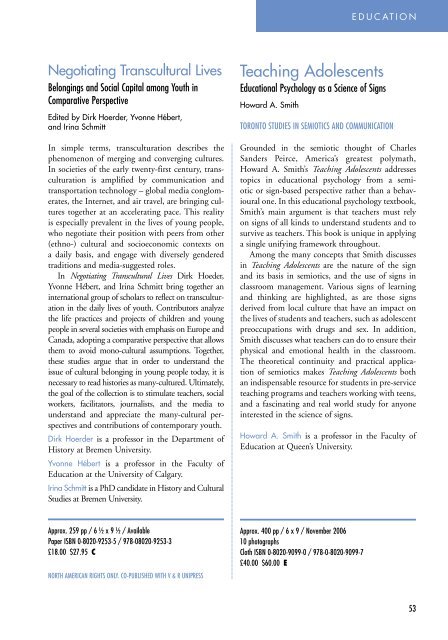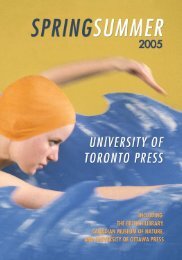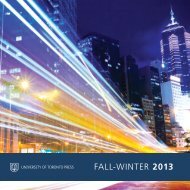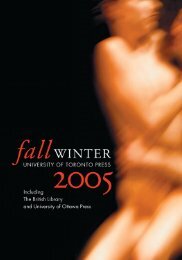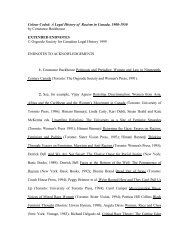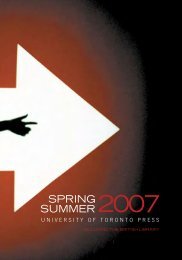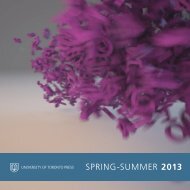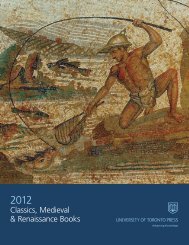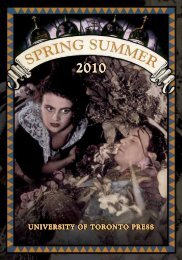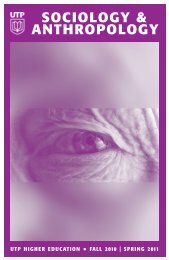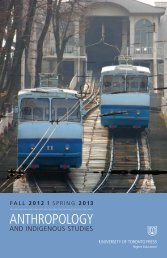Fall/Winter 2006 - University of Toronto Press Publishing
Fall/Winter 2006 - University of Toronto Press Publishing
Fall/Winter 2006 - University of Toronto Press Publishing
You also want an ePaper? Increase the reach of your titles
YUMPU automatically turns print PDFs into web optimized ePapers that Google loves.
E D U C AT I O N<br />
Negotiating Transcultural Lives<br />
Belongings and Social Capital among Youth in<br />
Comparative Perspective<br />
Edited by Dirk Hoerder, Yvonne Hébert,<br />
and Irina Schmitt<br />
In simple terms, transculturation describes the<br />
phenomenon <strong>of</strong> merging and converging cultures.<br />
In societies <strong>of</strong> the early twenty-first century, transculturation<br />
is amplified by communication and<br />
transportation technology – global media conglomerates,<br />
the Internet, and air travel, are bringing cultures<br />
together at an accelerating pace. This reality<br />
is especially prevalent in the lives <strong>of</strong> young people,<br />
who negotiate their position with peers from other<br />
(ethno-) cultural and socioeconomic contexts on<br />
a daily basis, and engage with diversely gendered<br />
traditions and media-suggested roles.<br />
In Negotiating Transcultural Lives Dirk Hoeder,<br />
Yvonne Hébert, and Irina Schmitt bring together an<br />
international group <strong>of</strong> scholars to reflect on transculturation<br />
in the daily lives <strong>of</strong> youth. Contributors analyze<br />
the life practices and projects <strong>of</strong> children and young<br />
people in several societies with emphasis on Europe and<br />
Canada, adopting a comparative perspective that allows<br />
them to avoid mono-cultural assumptions. Together,<br />
these studies argue that in order to understand the<br />
issue <strong>of</strong> cultural belonging in young people today, it is<br />
necessary to read histories as many-cultured. Ultimately,<br />
the goal <strong>of</strong> the collection is to stimulate teachers, social<br />
workers, facilitators, journalists, and the media to<br />
understand and appreciate the many-cultural perspectives<br />
and contributions <strong>of</strong> contemporary youth.<br />
Dirk Hoerder is a pr<strong>of</strong>essor in the Department <strong>of</strong><br />
History at Bremen <strong>University</strong>.<br />
Yvonne Hébert is a pr<strong>of</strong>essor in the Faculty <strong>of</strong><br />
Education at the <strong>University</strong> <strong>of</strong> Calgary.<br />
Irina Schmitt is a PhD candidate in History and Cultural<br />
Studies at Bremen <strong>University</strong>.<br />
Teaching Adolescents<br />
Educational Psychology as a Science <strong>of</strong> Signs<br />
Howard A. Smith<br />
TORONTO STUDIES IN SEMIOTICS AND COMMUNICATION<br />
Grounded in the semiotic thought <strong>of</strong> Charles<br />
Sanders Peirce, America’s greatest polymath,<br />
Howard A. Smith’s Teaching Adolescents addresses<br />
topics in educational psychology from a semiotic<br />
or sign-based perspective rather than a behavioural<br />
one. In this educational psychology textbook,<br />
Smith’s main argument is that teachers must rely<br />
on signs <strong>of</strong> all kinds to understand students and to<br />
survive as teachers. This book is unique in applying<br />
a single unifying framework throughout.<br />
Among the many concepts that Smith discusses<br />
in Teaching Adolescents are the nature <strong>of</strong> the sign<br />
and its basis in semiotics, and the use <strong>of</strong> signs in<br />
classroom management. Various signs <strong>of</strong> learning<br />
and thinking are highlighted, as are those signs<br />
derived from local culture that have an impact on<br />
the lives <strong>of</strong> students and teachers, such as adolescent<br />
preoccupations with drugs and sex. In addition,<br />
Smith discusses what teachers can do to ensure their<br />
physical and emotional health in the classroom.<br />
The theoretical continuity and practical application<br />
<strong>of</strong> semiotics makes Teaching Adolescents both<br />
an indispensable resource for students in pre-service<br />
teaching programs and teachers working with teens,<br />
and a fascinating and real world study for anyone<br />
interested in the science <strong>of</strong> signs.<br />
Howard A. Smith is a pr<strong>of</strong>essor in the Faculty <strong>of</strong><br />
Education at Queen’s <strong>University</strong>.<br />
Approx. 259 pp / 6 ½ x 9 ½ / Available<br />
Paper ISBN 0-8020-9253-5 / 978-08020-9253-3<br />
£18.00 $27.95 C<br />
NORTH AMERICAN RIGHTS ONLY. CO-PUBLISHED WITH V & R UNIPRESS<br />
Approx. 400 pp / 6 x 9 / November <strong>2006</strong><br />
10 photographs<br />
Cloth ISBN 0-8020-9099-0 / 978-0-8020-9099-7<br />
£40.00 $60.00 E<br />
53


